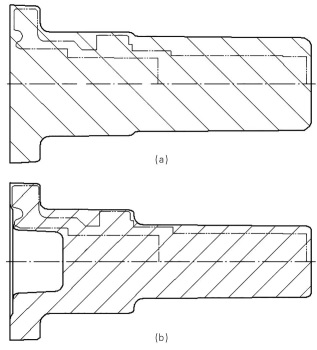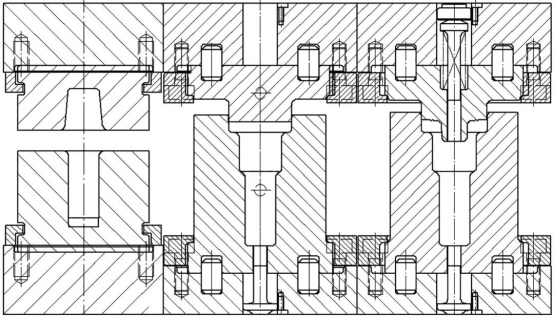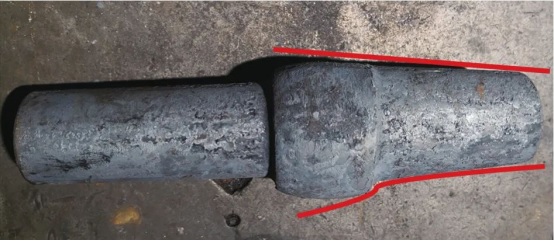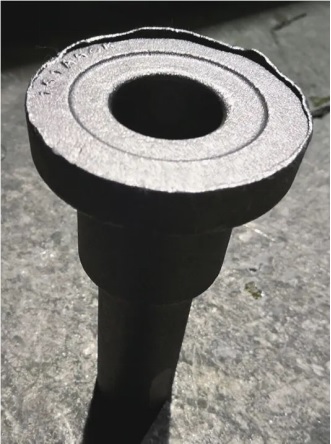A Complete Guide To Shaft Forging Process

Picture 1. Same product with different forging shapes
Selection of forming plan
After the drawing is determined, the next step is to design the forming plan for the forging. For the forgings in picture 1 (b) shape, there are 2 plans of hot forging closed forging.Plan A: The blank specifications are selected according to the step size of the middle part, and the final forging is formed by extruding the smallest diameter stem and upsetting the largest diameter flange.
Plan B: The specifications of the blank are selected according to the minimum diameter of the rod, and the final forging is formed by continuously upsetting the intermediate step and the largest diameter flange.
If we choose plan A, due to the difference between the blank specifications and the minimum diameter of the outer diameter of the shank by 20 mm, the length of the shank reaches 130 mm. It has been verified by practical experience that the rod cannot be completely filled. Therefore, only plan B can be selected. When plan B is selected, the ratio of billet length to diameter reaches 7.3, even if the micro deformation of the rod is not included, the upsetting ratio reaches 4.3. At this time, because the upsetting ratio of the forging far exceeds the stable ratio, it is easy to lose stability during upsetting. In order to realize the forming of forgings in three stations on the forging press, it is necessary to take measures in the design of the mold.
Mold design
Due to the large upsetting ratio, it is necessary to fully consider when designing the mold, and reasonably allocate the upsetting ratio of each station to ensure that the forgings of each station are well-formed.Use drawing software to simulate the forming of each station, determine the mold cavity size of each station, and form the mold assembly as shown in picture 2.

Picture 2. Mold assembly drawing
1. Upsetting station
When designing the upsetting mold, in addition to considering the forging upsetting ratio, the design of the mold structure also needs to consider the following factors.
(1)Ensure that the selected blank length can be put into the mold cavity. The selection of the blank specification length needs to consider the stroke of the equipment and the closing height of the mold. If the stroke of the equipment is less than the length of the blank, you can increase the gap between the upper and lower molds to meet the blank can be placed into the cavity. When placing the blank, the blank can be tilted first and placed into the cavity skewed. When the blank gradually falls into the lower mold, the blank is slowly straightened. This indirectly increases the length of the blank that the device can put into. If the cavity depth of the upper and lower molds is very deep, the strength of the remaining part of the mold cannot meet the forging impact strength of the material. At this time, the mold and the mold base can be designed as a whole to increase the strength of the mold and ensure the forging The mold does not break during the process.
(2)When blanking, the inclination of the end face of the blank has a great influence on the upsetting ratio. The inclination of the end face of the blank will cause uneven deformation of the blank during forming. At the end of the forming, the asymmetric deformation of the upset will appear as shown in picture 3.

Picture 3. Uneven deformation
If the inclination is very large, it may be necessary to reduce the forming upsetting ratio to make the forgings form well, which will affect the forming of the next few steps, which will eventually lead to the inability to form the forgings. Therefore, it is recommended to use the blanking method that can ensure the slope of the end face for blanking.
(3)The influence of error factors on forming. One of the effects of forging errors is that it will cause the instability of the blank upsetting, and the other is to cause folds in the next forming. If the accuracy of the equipment can ensure that the error is within the controllable range, the mold does not need to adopt an additional structure to ensure error. If it cannot, the upper and lower molds need to design locks to ensure the error of the forging. When designing the mold lock, in addition to paying attention to the lock gap value, the most important thing to note is the guide length of the lock. The length of the guide needs to be ensured. When the bottom of the upper mold cavity contacts the blank, the mold guide has been engaged, otherwise, the role of the designed lock will be greatly reduced.
(4) The effect of the gap between the upper and lower molds on the forming. The larger the gap value, the more accurate the volume of the forming part needs to be calculated, because there is no limitation of the cavity, and the change of the blank diameter at the gap is difficult to control. If the calculation is not correct, the deformation of this part will be too large. If the size of the pre-forging cavity is exceeded, the blank will not be completely placed in the pre-forging cavity. Lead to complete failure of forming.
2. Pre-forging station
In the design of pre-forging, it should be noted that the volume of the cavity must be larger than the volume of the blank, so as to ensure that the burr will not be extruded in the gap between the upper and lower molds when the pre-forging is formed. If there is a burr in the pre-forging, it will be pressed into the forging during the final forging to form a fold. If the pre-forging volume calculation is insufficient due to lack of practical experience, the pre-forging has a slight burr during production. We can also adjust the height of the device by fine-tuning to ensure that the shim is added to the final forging under the premise of no burr during pre-forging. Solve the problem.If the upsetting ratio of the forging still exceeds the normal value of upsetting without instability during pre-forging, at this time, we need to design the cavity for the pre-forging upper mold to ensure the forming effect of the forging.
3. Final forging station
The final forging mold is basically designed step by step, and it is enough to design the forgings according to the thermal dimensions. What needs to be paid attention to is the size of the upper jack. The design principle is to ensure the wall thickness of the core. If the wall thickness is insufficient, the core will be deformed during continuous production, resulting in the size of the groove part of the forging being unqualified. In addition, according to the actual situation, there is no need to push the jack, as long as the forgings are not sticky.
If the heading ratio is large, and the upper mold of the pre-forging has a cavity, the final forging still needs to form the forging. At this time, it is necessary to consider adding a guide structure. The principle is still that when the upper mold core contacts the pre-forging, the guiding mechanism has been guided, so as to ensure the size and error of the forging pit. Picture 4 shows the actual forgings produced by the final forging.

Picture 4. Final forging


